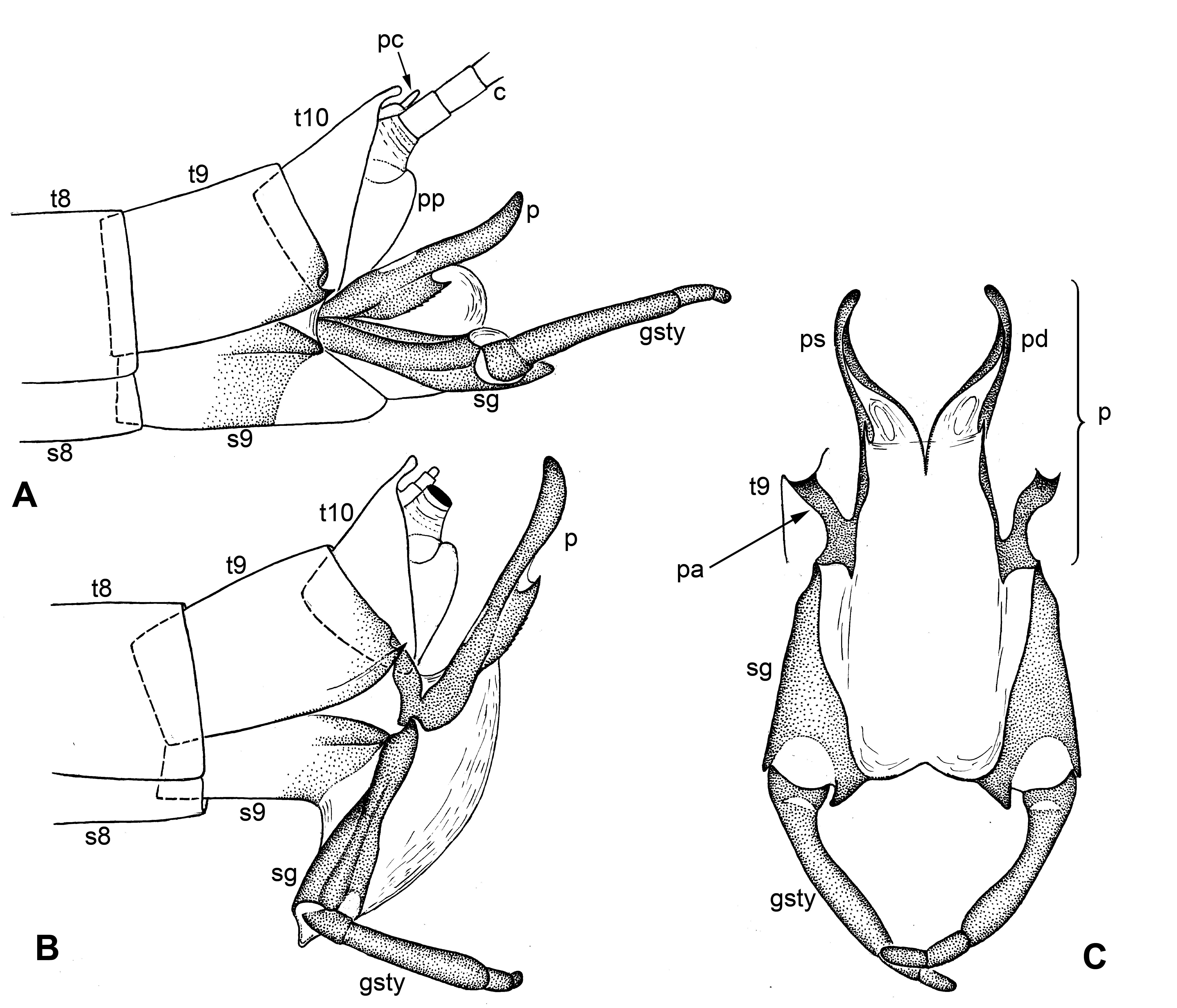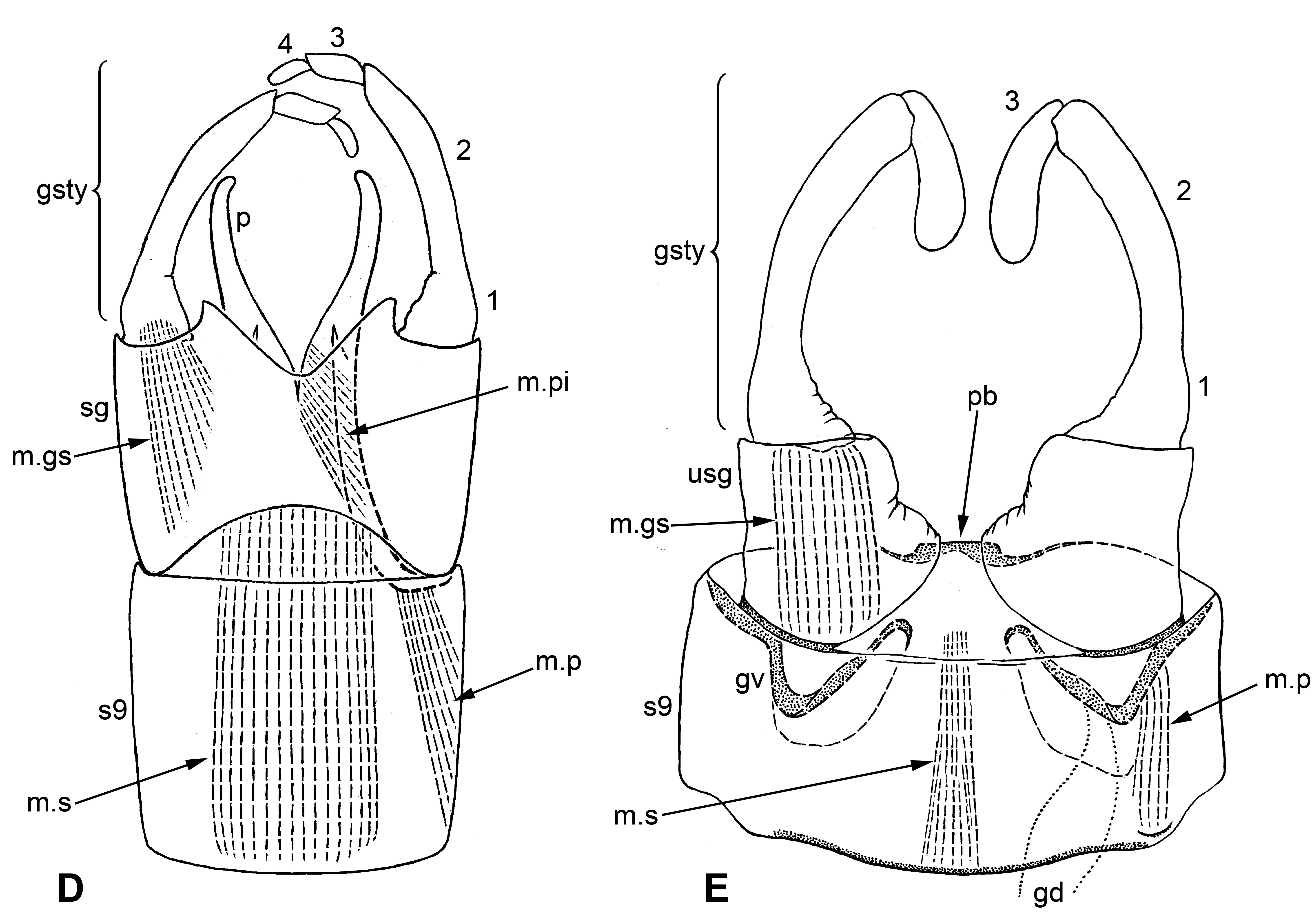
Abbreviations: c – cercus; gsty – gonostylus; p – penis; pa – penial arm; pc – paracercus; pd – right penis lobe; ps – left penis lobe; s8, s9 – abdominal sternites VIII and IX; t8–t10 – abdominal tergites VIII–X; sg – styliger.
GENITALIA OF MAYFLIES
 |
| Genitalia of Ameletus kamtschaticus: A – lateral view; B –
the same in excited condition; C – genitalia in excited condition,
posterior view. Abbreviations: c – cercus; gsty – gonostylus; p – penis; pa – penial arm; pc – paracercus; pd – right penis lobe; ps – left penis lobe; s8, s9 – abdominal sternites VIII and IX; t8–t10 – abdominal tergites VIII–X; sg – styliger. |
Function of genitalia: unpaired styligeral muscle (or sterno-styligeral muscle, m.s on Figs D and E) rotates the whole styliger ventrally; as a result of this, penial arms (pa on Figs B and C), being articulated both with the base of styliger and with tenth abdominal tergite, are rotated and protract penis (Figs B, C). This position allows to use gonostyli for grasping female abdomen, and at the same time allows to use penis as intromited organ (Kluge 2003, 2004).
Gonostyli. Some authors wrongly call them «forceps» (the term originally applied to modified cerci). Gonostyli are homologous to abdominal styli; as well as styli, they never have muscles inside and are moved by muscles located in styliger (gonostylar muscle, m.gs on Figs D and E). Gonostylus is divided into 4 muscle-less segments: 1st and 2nd segments are immovably fused together and sometimes poorly separated; 2nd segment is usually the longest one; 3rd and 4th segments (the apical segments) are relatively short and often flexibly articulated (Fig. D). In some taxa only one apical segment is present, so gonostyli are 3-segmented (Fig. E). Some authors use wrong numeration of gonostyli segments, when take the fused 1st and 2nd segments for one segment.
Modification of styliger in Baetidae: Initially for mayflies, styliger is integral and bears a pair of gonostyli; its lateral areas, which include styligeral muscles, are thickened (Fig. D). In Baetidae styliger is reduced, but its lateral areas with gonostylar muscles are retained and look like a pair of segment-like projections (Fig. E); they are termed either as gonostylar pedestals (Kluge 2004), or unistyligers (Kluge & Novikova 2011). Some authors wrongly regard these derivates of styliger to be the first segments of gonostyli. In connection with loss of middle part of styliger, sterno-styligeral muscle can undergo reduction: in the most primitive baetid taxa (e.g., Afroptilum) sterno-styligeral muscle is well developed, but instead of rotation of styliger ventrally, it brings unistyligers together; in some taxa (e.g., Cloeon) sterno-styligeral muscle remains to be well developed, but does not function; in some taxa sterno-styligeral muscle is more or less weakened (Fig. E); in some taxa (e.g., Labiobaetis, Rhodobaetis) it is completely lost (Kluge & Novikova 2014).
Modification of penis in Baetidae: Penis lacks intrinsic muscles and consists of a penial bridge (with or without median projection) and a pair of gonovectes. In some taxa gonovectes are fused with penial bridge; in Baetovectata, vice verse, gonovectes are especially flexible (Fig. E) (Kluge & Novikova 2011).
 |
|
Musculature of genitalia, ventral view: D – Ameletus kamtschaticus; E – Acentrella lapponica. Abbreviations: 1, 2, 3, 4 – segments of gonostylus; gsty – gonostylus; gv – gonovectis; m.gs – gonostylar muscle (located inside styliger or unistyliger, attached to base of gonostylus); m.p – penial muscle (locates inside abdominal sternum IX, attached to base of penis); m.pi – intrinsic penial muscle (locates inside penis); m.s – styligeral muscle (locates inside abdominal sternum IX, attached to base of styliger); p – penis; pa – penial arm; pb – penial bridge; pc – paracercus; s9 – abdominal sternite IX; sg – styliger; usg – unistyliger. |
Publications:
[Kluge N.J.] Êëþãå Í.Þ. 2003. Îá ýâîëþöèè è ãîìîëîãèè ãåíèòàëüíûõ ïðèäàòêîâ íàñåêîìûõ. // Òðóäû ÐÝÎ, 74: 3–16. PDF [About evolution and homology of genital appendages of insects. // Trudy Russkogo Entomologicheskogo Obshestva / Proceedings of the Russian Entomological Society, 74: 3–16] (in Russian).
Kluge N. 2004. The phylogenetic system of Ephemeroptera. // Kluwer Academic Publishers. p. i–xiii + 1–442 PDF
Kluge N.J. & Novikova E.A. 2011. Systematics of the mayfly taxon Acentrella (Ephemeroptera, Baetidae), with description of new Asian and African species. // Russian Entomological Journal 20 (1): 1–56. PDF
Kluge N.J. & Novikova E.A. 2014. Systematics of Indobaetis Müller-Liebenau & Morihara 1982, and related implications for some other Baetidae genera (Ephemeroptera). // Zootaxa 3835 (2): 209–236. HTM